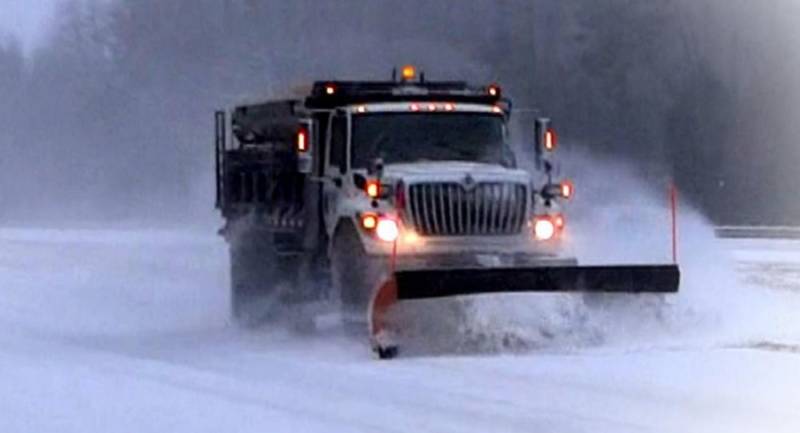Now that snow has arrived, the Municipality of Chatham-Kent’s Public Works Department is communicating answers to some of the most Frequently Asked Questions (FAQs).
Municipal officials say the co-operation of residents and business owners is needed to efficiently complete these operations.
For more information on the Chatham-Kent Public Works Department and other municipal services, visit www.chatham-kent.ca.
Here are the answers to those FAQ:
Which streets get plowed first and why?
Streets designated as “priority” are cleared first, then crews take care of the remainder of the streets.
Clearing Chatham-Kent’s 3,500 km of roads require planning and prioritization to make sure the most citizens can have clearer roads in the shortest possible time.
Each road is part of a predetermined route to ensure maximum use for the 78 pieces of snow clearing equipment.
Each route is made up of a street list starting with the priority roads. Priority roads carry the higher volumes of traffic and are most easily identified as main (arterial) roads or secondary collector roads. These are the roads motorists use to get to business areas, hospitals and in and out of the city. Public and school bus routes are also considered in the first round of snow removal.
The other roads are primarily residential or secondary routes and these are systematically plowed after the “priority” routes are completed.
Most routes are assigned to one snow clearing unit, but in the case of the core area or multi-lane roads more units are provided. Public Works Road Crews have a detailed list of streets in their “route” to help ensure that all are cleared. The snow clearing equipment is tracked using a global positioning
Why are cul-de-sacs the last to be plowed?
Cul-de-sacs are plowed during the local street plowing process. Occasionally regular plow equipment cannot fit in the limited space and smaller plow equipment may be required. Cul de sacs have lower daily traffic volumes which a lower priority.
Who determines which streets get plowed first?
Chatham-Kent follows the standards for winter maintenances established by the province,
Roads are categorized into five main classes. Class 1, 2 and 3 roads, which include arterial and some secondary collectors, and larger rural roads take first priority. Classes 4 and 5, which include rural and local streets and cul-de-sacs, have less priority.
When are salt and sand used on roads?
Salt use is kept to a minimum but is required to prevent the formation of ice or to melt existing ice. It is spread only on paved roads. We use modern technology in the application of this material and keep up-to-date on new developments. Salt usage is tracked and reduction measures are implemented as appropriate. Our public works staff routinely examines information on alternative de-icing and anti-icing technologies. The goal is to be proactive in this area recognizing that the safety of city streets during slippery conditions must not be jeopardized by the use of alternative products.
Sand can be used on snow packed local streets at intersections, curves and hills. We typically don’t sand the entire street.
Why are there roads that do not receive winter maintenance?
There a few roads that have been identified as low traffic with no residents. In order to control spending, these roads do not receive winter maintenance. These roads are clearly signed and motorists use them at their risk.
When does the municipality declare a snow emergency?
The Mayor, Chief of Police Services and General Manager of Infrastructure and Engineering Services can declare a snow emergency.
This places parking bans on the roads to allow the winter maintenance equipment access to the roads and provides room to push the large volumes of snow to the side of roadway to be picked up later. As a rule of thumb, declaring a snow emergency will be considered when there is a forecasted 20cm of snow with 40km/h winds. The average costs for winter maintenance for a 20 cm winter event is $500,000.
Who removes the snow from sidewalks?
Chatham-Kent provides mechanical snow clearance on the 410 km sidewalk network with a mix of municipal staff and contracted service providers. Sidewalks winter maintenance routes are also prioritized and are separated in three classes in order of priority:
– Class I – Downtown business areas are to have snow and ice removed to as near bare concrete as feasible, plus spreading of abrasives (salt and/or sand when required).
– Class II- Mains, Arterial, collector streets, bus routes, hospital areas, school areas and bridge structures are to be plowed to at least a snow pack condition. Abrasives (salt and/or sand) are not to be applied.
– Class III- Local residential, minor collector streets are to be plowed to at least a snow pack condition. Abrasives (salt and/or sand) are not to be applied.
Why haven’t the bus stops been cleared?
The bus stops with a shelter are cleared of snow by the bus service provider. The bus terminal in Chatham is cleared by Public Works. Other bus stops are not cleared of snow by the municipality.
Why doesn’t the municipality clear walkways?
In order to control costs, walkways, paths and sidewalks not within a road allowance and running parallel to a highway will not receive any winter control, such as plowing. This will include, but is not limited to paths in parks.
Does the municipality come back to remove snow its plows have dumped in my driveway?
Owners and/or occupants of residential and business properties are responsible for keeping driveways clear down to the street. Because street plowing operations push snow from the road to the boulevard, this does fill in driveways. Unfortunately, the municipality does not have the resources to come back to remove snow left by its plows at the end of driveways.
How come the plow damages my sod every year and when is it going to be repaired?
Sod damage is the result of two factors:
1. The plow operator may have difficulty finding the sidewalk or the edge of the road under a blanket of snow, or
2. If the ground is not frozen.
Once a path is cleared, subsequent trips by the sidewalk plow are made easier. If the sod was damaged during the first pass of the season then the damage may not be discovered until the snow melts. The cost to repair sod damage is relatively minor because we have found that homeowners will repair the damage in front of their property before the municipal crews arrive. This is a tremendous help because Municipal staff typically don’t repair sod damage until May when the summer seasonal workforce is in place.
Is it okay to push snow onto the roadway or to the boulevard area across the street?
Under the Highway Traffic Act, placing snow or ice on a roadway is prohibited.
What if I am unable to clear the snow from my property because of age or disability?
Unfortunately, snow removal services for seniors and individuals with disabilities are not available from municipal crews. You may be able to get assistance from a family member, a friend or a neighbour. Many local community groups and churches have volunteers who will lend a helping hand. There are a number of private snow clearing firms who also provide this service.
The snow bank at the corner is too high and I cannot see oncoming traffic. What can be done?
Every attempt is made to keep snow banks at corners to a minimum. Special concerns should be directed to a Customer Service Representative at 519-360-1998 or CKinfo@chatham-kent.ca
My mailbox has been damaged by the plow. What can be done?
If the box was physically hit and damaged by the snow clearing equipment, the municipality will provide a new mailbox but it may not an exact replacement of the existing mailbox. If the mailbox is knocked over by the snow being pushed by the equipment, then the municipality will not replace the box. Concerns should be directed to a Customer Service Representative at 519-360-1998 or CKinfo@chatham-kent.ca
How much snow does Chatham-Kent receive?
– On average, Chatham-Kent receives just over 79 centimetres (7 feet) of snow each winter. A major snowfall can produce an accumulation of 20centimetres (8 inches) of snow with large snow drifts from the high winds. The winter maintenance cost for a 20cm snow event is estimated at $500,000.
– On average Chatham-Kent has 22 days annually with snow fall.
– There are circumstances with high winds or below freezing temperature and freezing rain without snowfall where winter maintenance equipment to clear snow drifts and to remove ice.
What can I do to help?
– Be patient. In heavy snowfalls it takes us longer to get all our streets cleared.
– Be a good neighbour. Help those who may not be able to shovel their driveways and sidewalks.
– Don’t park on the street during a snowfall – or immediately following a snowfall if plowing is still needed. Also, please do not park your vehicle at the very end of a driveway or across the sidewalk/boulevard area. Public Works operators are not able to do their job properly if there are parked vehicles in the way.
– Clear snow and ice from your driveway. Please do this right to the street, that is, across the boulevard area adjacent to your property. The municipality also recommends that you sand or salt your driveway, particularly if there is a chance it might be used by others say, to avoid walking on an icy patch of sidewalk or to cross the street to reach a bus stop or mail box.
– Keep driveways clear of any shoulder snow accumulations from street or sidewalk plowing.
– Don’t place snow from sidewalks or driveways on the street or sidewalks, because it creates a hazard for vehicles and pedestrians.
Anyone having questions or concerns, or wishing to report a problem, should call a Customer Service Representative at 519-360-1998 or CKinfo@chatham-kent.ca















